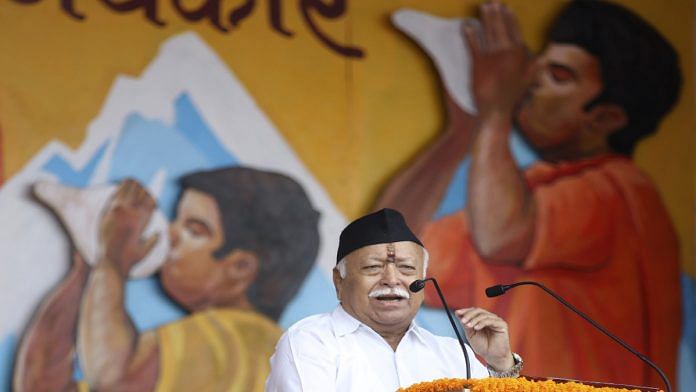As is the norm every year, RSS Sarsanghchalak Mohan Bhagwat delivered his Vijayadashami speech in Nagpur on Wednesday, where he highlighted the need to build consensus on population control and seriously consider Uniform Civil Code as a contributory aspect towards achieving population balance.
Economic growth, GDP and equitable distribution of resources have direct relationship with population policy. Higher population growth does not necessarily indicate demographic dividend or economic advantage. China with 18.6 percent share in world population clocks $12.24 trillion GDP whereas the US with 4.3 percent population share accounts for $19.39 trillion GDP and the European Union with 5.8 percent has $17.28 trillion GDP.
China’s one-child policy and the reversal of it merits a deeper study to understand its effects on economic growth and social issues. Needless to say, India with its socio-political complexities needs an in-depth analysis and independent policy recommendations.
Bhagwat, in his speech, also hinted at Uniform Civil Code (UCC) as one of the measures to tackle the issue of population growth imbalance. Enlisting some of the challenges in today’s context, the RSS chief devoted a good part of his speech to draw the policymakers’ attention to this issue while emphasising on the need for social participation in government initiatives.
Also read: Muslims poorer, less educated than Hindus. But their kids more likely to survive till age 5
Population control measures
Attempts to focus on population control are neither new nor limited to mere policy-level debates. The first bold initiative was launched in 1951 as a state-sponsored family control programme with the objective of taking preventive steps before the ‘population explosion’ occurs. This initiative led to a number of legislations, review committees and reports aimed at gauging the seriousness of the challenge and taking remedial measures.
As per the Registrar General of India, the country’s decadal growth rate was 17.64 percent in Census 2011. The ‘World Population Prospects, 2019’ report by the United Nations Department of Economic and Social Affairs, projects India’s population at 146.9 crore by 2027. Taking this into consideration the government is committed to implement the family planning programme, which follows the tenets laid down under the National Population Policy 2000 and National Health Policy 2017 for addressing the unmet need for family planning and checking population growth.
The National Population Policy 2000 envisaged a Total Fertility Rate (TFR) of 2.1. Quoting the recently published NFHS report which comes out every five years, the RSS leader informed that the TFR has actually come down to 2.0. This inter alia signifies the phasing out of large joint families and the mushrooming of “ultra nuclear families” which according to the RSS is at the root of insecurity and loss of social values.
While population growth is “a reality” and requires focussed attention, the crass urbanisation, lack of rural infrastructure development and employment and uneconomical agriculture are issues that directly affect demographic change and population imbalance. The RSS with its mass appeal, cadre base and ability to influence the policies of the government should initiate a national debate on these issues as well.
Also read: Former CEC S.Y. Quraishi busts myths about Islam and family planning in his new book
Go beyond statistics
Incidentally, former Chief Election Commissioner S.Y. Quraishi, one of the few Muslim leaders who recently had a meeting with RSS chief, has welcomed Bhagwat’s comments and called for family planning to be adopted by “all sections of the Indian society”. While Qureshi, the author of The Population Myth: Islam, Family Planning and Politics in India and the RSS chief have not referred to any one particular community, Hyderabad MP and AIMIM president Asaduddin Owaisi has claimed that there is a sharp decline in the fertility rate of Muslims and hence there is no need for population control or balancing.
While the growth rate of Muslim population may have declined — from 30.9 percent during 1961-71 to 24.6 percent during 2001-11 — the community’s contribution in the overall growth in the country’s population has steadily risen — from 14.6 percent (1901-2011) to 16.1 percent (1951-2011) to 16.7 percent (1971-2011). Moreover, the Muslim population living in urban ghetto-like clusters results in issues such as segregation and marginalisation, which can be potentially used for vote-bank politics.
It is in this context that the views of the RSS and a section of Muslim intellectuals assume greater importance in emphasising the need to go beyond statistics and comprehend the realities of the situation. The population growth issue needs to be discussed nationally in a positive and non-political atmosphere.
The author is the former editor of ‘Organiser’. He tweets @seshadrichari. Views are personal.
(Edited by Prashant)



